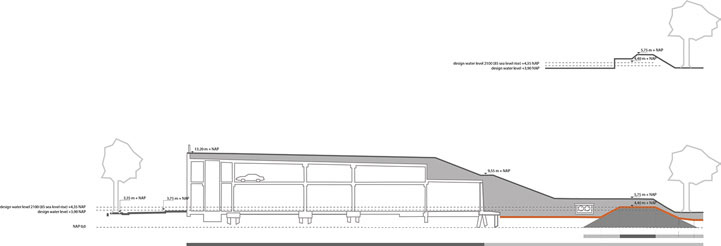A comparative approach to assess spatial and structural integration
Downloads
DOI:
https://doi.org/10.7480/rius.3.841Abstract
Due to the changing climate and increasing urbanisation delta cities are faced with an increasing flood risk. In The Netherlands many of the flood defence infrastructures, such as dikes and flood walls, need to be adapted or improved in the near future, to comply to current or improved safety standards. These improvements directly affect landscape and urban development. In its 2008 report, the 2nd Delta Committee presented the idea of multifunctional flood defences, which are flood defence structures that deliberately provide opportunities for other functions. Since then, spatial designers and hydraulic engineers together delivered a wide palette of designs and concepts, resulting in a rather fluid and indefinable concept of multifunctional flood defences. This paper presents a method to describe the level of multifunctionality, based on two existing spatial and structural assessment methods from the fields of civil engineering and urban planning. The combined method distinguishes four ascending levels of integration, ranging from spatial optimisation to structural and functional integration. The combined classification method is tested on a selection of cases of multifunctional flood defences in the Netherlands. Based on this test, it is concluded that the classification method is a useful and generic method to describe the level of multifunctionality. Some of the selected examples look very innovative and multifunctional at first glance, while the level of spatial and structural integration is limited. Other examples might not be very spectacular from a spatial designers point of view, but show that true functional integration of flood protection with multiple other functions is already feasible, depending on the local context. The method helps to bridge the gap between the practices of civil engineering and urban and landscape design. Also, it makes clear that flood risk management is part of an overall process of integrated area development, anticipating on what could be described as a multifunctional flood defence zone.
How to Cite
Published
Issue
Section
License
Copyright (c) 2015 Peter van Veelen, Mark Voorendt, Chris van der Zwet

This work is licensed under a Creative Commons Attribution 4.0 International License.
References
Ten Brinke, W. & B. Bannink (2004) Risico's in bedijkte termen, een thematische evaluatie van het Nederlandse veiligheidsbeleid tegen overstromen. RIVM rapportnummer 500799002
Bruijn, K. de & F. Klijn (2011) Deltadijken: locaties waar deze het meest effectief slachtofferrisico's reduceren, Deltares report 1202628-000-VEB-0005
City of Rotterdam (2008) Bestemmingsplan Vierhavensstraat en omgeving
Delta Committee, 2nd (2008) (‘State committee for sustainable coastal development’) Samen werken met water. Den Haag, Hollandia Printing
Ellen, G.J., et al. (2011) Multifunctioneel landgebruik als adaptatiestrategie - Puzzelen met ondernemers en beleidsmakers. Kennis voor Klimaat report nr.: KvK/036/2011
Erfgoed centrum DiEP, archiefstuk1580, Rapport van vergelijking tussen drie schetsplannen voor een oplossing voor de waterkering Noordendijk tussen de Noordersluisdam en de Groenendijk te Dordrecht
Erfgoedcentrum DiEP, archiefstuk 1581, Bestek en stukken betreffende het bestek van openbare aanbesteding van het uitvoeren van dijkversterkingen aan de Noordendijk, vanaf de Oranjelaan tot aan het voormalige gemaal Jantzon aan de Molenvliet te Dordrecht.
Heems, G.C. & B.L.M. Kothuis (2012) Waterveiligheid: Managen van kwetsbaarheid voorbij de mythe van droge voeten. De Nederlandse omgang met overstromingsdreiging in sociaal-cultureel perspectief. PhD Thesis University of Maastricht. Amsterdam, Waterworks
Hooimeijer, P., H. Kroon & J. Luttik (2001) Kwaliteit in meervoud. Conceptualisering en operationalisering van ruimtelijke kwaliteit voor meervoudig ruimtegebruik. Gouda, Habiforum, Expertisenetwerk Meervoudig Ruimtegebruik
Huis in ’t Veld et al. (1986) Proefproject dijkverbetering Sliedrecht. Utrecht, Rijkswaterstaat
Kennisbank Platform31 (2013) Website http://kennisbank.platform31.nl/pages/23611/Projecten/Dakpark-Rotterdam.html [Accessed June 2013]
Koekkoek, Th. (2013) Notes of an interview by M.Z. Voorendt on 5-6-2013.
Kolen, B., B. Maaskant & F. Hoss (2010). Meerlaagsveiligheid: Zonder normen geen kans. Ruimtelijke veiligheid en risicobeleid 2: 18-25
Leeuwen, J. van der (2008) Dakpark Vierhavenstrip - Multifunctionele waterkering in Rotterdam. Presentation. City of Rotterdam
Merkenhof, E. van den & W.L. Schipper (1998) ‘Dijkwoningen als waterkeringen’, Vakblad Cement 50 (7): 20-23
Ten Brinke, W.B.M. & B.A. Bannink (2004) Risico's in bedijkte termen, een thematische evaluatie van het Nederlandse veiligheidsbeleid tegen overstromen. RIVM rapport 500799002, Beleidsmonitor Water
I & M, Ministry of (Ministry of Infrastructure and the Environment (2009) Nationaal Waterplan 2009-2015. The Hague, Ministry of I & M
Nelson, H.G. & E. Stolterman (2012) The design way. Intentional change in an unpredictable world. Cambridge, Massachusetts/London, United Kingdom, The MIT Press
NEN-EN (1990) Eurocode 0: Basis of structural design’. Delft, Nederlands Normalisatie Instituut
Moel, H. de et al. (ed.) (2010) De Klimaatdijk in de praktijk, gebiedsspecifiek onderzoek naar nieuwe klimaatbestendige dijkverbeteringsalternatieven langs de Nederrijn en Lek, Kennis voor Klimaat 019
Palmbout Urban Landscapes (2009), Stedenbouwkundig ontwerp Parkstad/Afrikaanderwijk, Palmbout Urban Landscapes. By order of City of Rotterdam & Vestia/Estrada
Technische Adviescommissie voor de Waterkeringen (TAW) (1998) Grondslagen voor waterkeren. Rotterdam, A.A. Balkema
Technische Adviescommissie voor de Waterkeringen (TAW) (2003) Leidraad Kunstwerken. Delft, Rijkswaterstaat (RWS), Dienst Weg- en Waterbouwkunde
Tromp, E., H. van den Berg, J. Rengers & E. Pelders (2012), Multifunctionele Waterkeringen onderzoek naar de mogelijkheden voor flexibel gebruik van de waterkering. Deltares report 1205973-007
Veelen, P.C. van, F. Boer, R. Hoijink, H.A. Schelfhout & C. Haselen (2010) Veilige en goed ingepaste waterkering in Rotterdam. Rotterdam, RCP
Veelen, P.C. van (2013) Multifunctional water defences, linking spatial development with water safety. Proceedings Congress Water and the City, Delft, 14-15 June 2012, to be published.
Venmans (1992) Report State of the art Dutch dyke technology. Delft, GeoDelft
Waterschap De Groote Waard (1997) Several technical drawings for the licence application. Gemeentearchief Dordrecht [May 2013]
Waterschap Hollandse Delta (2010) Legger primaire waterkeringen




